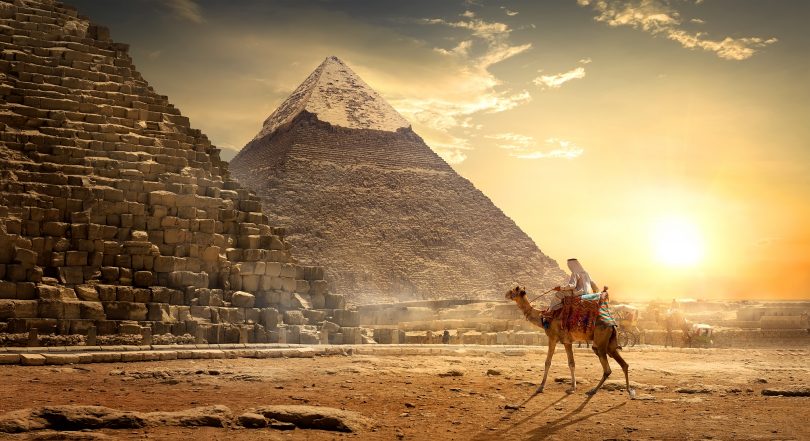Cannabis has been used for millennia. With evidence that it was used in ancient China and India it is hard to deny that this naturally occurring wonder plant has been here for an incredibly long time, and we want to find out more about its incredible history. As part of our investigation of the history of cannabis, let’s take a trip back to one of the most important eras of ancient history, a land of mummies, pharaohs, pyramids and gods – Ancient Egypt.
As part of our series on the history of cannabis, looking at the prevalence and importance of cannabis throughout human history we are going to stop off first in Northern Africa, specifically, Egypt. The Ancient Egyptians were pioneers in many areas of society and culture, creating one of the earliest forms of written language in Hieroglyphics and changing approaches to medicine and burial, but were they pioneering enough to understand the myriad uses of our favourite plant and its component parts, cannabis?
In this article I’ll look at some of the historical evidence that may point towards a link between Egyptian medical knowledge and cannabis, as well as a more spiritual use of the drug. We’ll look at the difference between cannabis and hemp and whether both species of plant were used by the beloved pharaohs. We’ll even peep beneath the mummy’s wraps and see if those hieroglyphics were actually more high-roglyphics.
Cannabis culture is exciting, and it spans back much further than most people realize. Humans have been utilizing marijuana’s many benefits for thousands of years, and that’s unlikely to ever change. For more articles like this one, make sure to subscribe to The THC Weekly Newsletter. Also save big on Delta 8, Delta 9 THC, Delta-10 THC, THCO, THCV, THCP & HHC products by checking out our “Best-of” lists!
Who Were the Ancient Egyptians?
Ancient Egypt is a rather broad term that denotes the ancient civilisations that inhabited the northern part of Africa (modern day Egypt) from around the 4th Century BC until the fall of the Roman Empire in the 1st Century AD. The civilisation was mostly centred around the very fertile river Nile and is characterised by the pharaonic structure of society, where the order of hierarchy went gods, pharaohs, and humanity. From this, great structures and mausoleums were constructed including the iconic great pyramids, built in the 3rd Century BC from thousands of tonnes of stone, they have come to represent the Egyptians to many people around the world.
Egyptian society was relatively advanced for its age. Operating in a fully agricultural way, with a complex writing system in the hieroglyphic language (something Britain didn’t develop until the 6th Century BC). Egyptian medicine as well led to some useful discoveries, including an understanding of mental illness, circulation and hygiene to prevent diseases. So, with a seemingly developed medical understanding and a complex civilisation it is very reasonable to ask, did they have a relationship with cannabis?
Cannabis & Hemp
Before looking at the role cannabis played in Ancient Egypt, it’s first useful to define what we mean by cannabis historically. The Genus cannabis refers to a number of species of the plant. cannabis Sativa and cannabis Sativa L are the two we will be examining. Cannabis Sativa L is the latin name for Hemp, the non psychoactive variant of cannabis that has played a huge role historically, being used as fibre, material and medicine worldwide. Cannabis Sativa is perhaps the variant that we are much more familiar with, the psychoactive variety of cannabis with a higher concentration of the Cannabinoid THC which produces the effects we know and love from cannabis. The history of these two Species of plant are often intertwined and where this one, there is usually the other as they can often be grown from each other with little effort. So, with this distinction, let’s look at Ancient Egypts relationship with cannabis.
Cannabis in Egypt
There have been soil analyses done on Egyptian soil that suggest cannabis was present in the region throughout antiquity. The codex of ancient Egyptian plant remains even found traces of cannabis seeds and it is well known that fibrous plants (most likely hemp) were used to create chords and ropes. There is even a god called Sheshat, who is often depicted wearing a leaf that bears a striking resemblance to a Cannabis plant, over her head. Sheshat was a god that was used to open up the ‘doors of heaven’ to the dead.
However, even with this knowledge and with Sheshat’s symbol, Egyptologists have argued for many years over the use of cannabis in ancient Egypt due to the seeming lack of a common term used by Egyptian doctors that may have meant cannabis. As with many ancient languages, it takes time and a lot of deciphering to understand what some things are referred to as, take the mystery of ‘Soma’ a psychoactive drink that was used across India and Persia. For years the identity of the main ingredients of Soma were debated, but recent theories claim it to be cannabis.
For cannabis in Ancient Egypt, other names may have been used. A core candidate is the name Sheshemet. Sheshemet is a plant that was seemingly used in many medical procedures and for many years had eluded Egyptologists as to what it was. Then some professors noticed that Sheshemet was one of the few medical substances that was also referenced as being used for rope. From this moment onwards it became clear that Sheshemet must have been referring to cannabis, as cannabis Sativa L, Hemp, is one of the few historically grown plants that has been used for fibres as well as being used for medical purposes. A debate still exists within the Egyptologists over whether it is truly accurate to label Sheshemet as Cannabis, but many now accept that it is a likely connection.
Cannabis in Medicine
With an Egyptian name for cannabis established, it is much easier to analyse how it may have been used within Egyptian culture. There is some evidence that the Egyptians used cannabis, sheshemet, in their medicine for a number of reasons. Ancient papyrus texts refer to cannabis being applied as an ointment, sometimes mixed with honey as a cure-all for the following disorders.
The Ramesseum Papyri, dated back to around 1700 BCE lists a host of Egyptian treatments, one of which included ‘celery, cannabis is ground and left in the dew overnight. Both eyes of the patient are to be washed with it in the morning to treat eye conditions. Vaginal conditions were also treated with ground up cannabis (Sheshemet) mixed up with honey, as also listed in the Ramesseum Papyri. A more modern papyrus called the Berlin Papyri gives a list of medical formulae for various conditions. The 81st formula says that cannabis could be given to patients to drive away a fever. This almost seems to fit with what we now understand about CBD and its anti-inflammatory
The Viennese papyrus from around the 2nd Century AD, so much nearer the end of what we would classify as ancient egypt, says that pouring ‘wild water cucumber, thorn acacia, cannabis undivided; to be triturated finely’ into the ear will cure acute ear pains. Many papyri from across different eras and regions of Egypt seem to suggest that cannabis was being used for many medical purposes. This is evidence that the Egyptians understood what a wonder plant cannabis is. Though they may not have been able to identify the different properties of the Cannabinoids CBD and THC, it seems like they were way ahead of their time in using them in treatments such as pain-relief and anti-inflammatory oils, which we now know CBD and THC can be used for.
The Presence of Cannabis in Mummys
So, cannabis was clearly used in a myriad of medical ways, but perhaps it was also consumed for other practices, maybe even a more ceremonial process. There is evidence that a scent, inhaled by priests and pharaohs and used as a perfume called Kyphi, may have included cannabis. If this scent was used, we would probably find some signs that pharaohs and priests inhaled cannabis. And indeed, incredibly, there seems to be evidence that there are detectable THC levels in mummies themselves, suggesting that cannabis may even have been inhaled in egyptian times.
A study analysed lung and body fragments of Mummies and found high levels of THC (as well as Nicotine and Cocaine surprisingly). Further research by an endocrinologist called Svetlana Balabanova on hair strand analyses and pulverised samples also confirmed the presence of cannabis in Mummy samples. There has been some criticism of these studies as some people have argued that the samples were contaminated after the mummies had been discovered, but to me it is rather compelling evidence that at least the upper classes in ancient egypt were using cannabis in their day to day lives.
Conclusion
It is clear to see that the Egyptians were familiar with the multitude of medical benefits cannabis has on offer. The references to it in medical papyri, the evidence from Mummy samples, the Egyptians knew what a wonderful plan cannabis was. Though of course with all Ancient History we must acknowledge that interpretation and extrapolation of certain words and pieces of evidence is key and some have argued that Sheshemet and other names may not refer to cannabis. I personally believe that the evidence is there and we can quite accurately accept that cannabis played a very important role in Egyptian life, medicine and culture.









